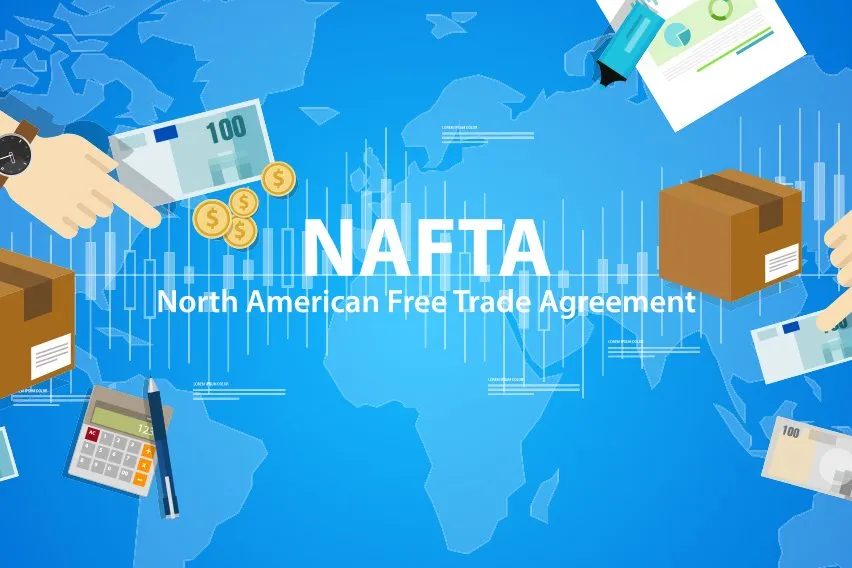What is NAFTA (North American Free Trade Agreement)?

If you’re running or starting up a small business you may have heard people talk about NAFTA or USMCA.
Running a business is difficult and time-consuming. This means it can be tough trying to keep up with all the different terms and agreements.
That’s why we’re here to help guide you through.
Here’s What We’ll Cover:
What Is the North American Free Trade Agreement (NAFTA) and Why Was It Implemented?
What Were the Effects of NAFTA?
What Is the North American Free Trade Agreement (NAFTA) and Why Was It Implemented?
The North American Free Trade Agreement (NAFTA) was signed by U.S. President George H.W. Bush in 1992 and implemented on January 1st, 1994. It was first talked about under President Ronald Reagan, who included the idea in his 1980 presidential campaign.
Its main aim was to remove trade barriers. This in turn would help promote trade and to protect intellectual property rights in North America between the U.S., Canada and Mexico.
The agreement eliminated most tariffs on trade in North American countries. This allowed businesses to trade without as many financial and logistical restrictions.

These tariffs, particularly those related to large industries, were phased out bit by bit between 1994 and 2008.
NAFTA was inspired by the success of the European Economic Community. This ran from 1957 to 1993, and helped eliminate tariffs to stimulate trade among its members.
The main argument for establishing the free-trade area in North America was to increase trade and production. This would mean all three countries would benefit financially. There was also a hope it would create millions of well-paying jobs.
Controversy and Criticism
As with any new legislation, NAFTA had its critics.
They viewed NAFTA as a ploy put together by multinational corporations to increase their profits. They feared this would come at the expense of the citizens of North America.
They argued that the new rules and regulations NAFTA would impose would undermine local government’s power.
They were also worried that environmental and health standards would drop. Family farmers feared they would be displaced and there would be huge job losses across North America.
What Were the Effects of NAFTA?
NAFTA is commonly viewed as a mixed bag of results.
Mexican trade did experience a large increase in its exports. In the period between 1994 and 2013, their exports went from around $60 billion to nearly $400 billion. This in turn created a surge of imports, resulting in better-quality and lower-priced goods for the Mexican people.
In the end, neither the proponents nor the critics were proved correct. Economic growth post-NAFTA was not impressive for any of the countries involved.
Mexico’s Gross Domestic Product (GDP) grew at a lower rate than other countries in Latin America such as Brazil or Chile. Plus its growth in income per person didn’t increase significantly.
It is argued that the United States and Canada’s statistics were skewed due to the Great Recession of 2007 to 2009. This period would have wiped out any benefits that NAFTA may have brought about.
Due to the immigration restrictions, the wage gap between Mexico, and the U.S. and Canada did not decrease. And once the lack of pre-existing infrastructure in Mexico was taken into account, many U.S. and Canadian businesses choose not to invest.
NAFTA and USMCA
When U.S. President Donald Trump came into office in January 2017, he set out to scrap the U.S. involvement in the trade deal and to renegotiate NAFTA. He famously referred to NAFTA as the “worst trade deal maybe ever signed anywhere”.
After years of tense negotiations, and a near trade war, on November 30th, 2018 a new agreement was signed in North America.
Trump, Canadian President Justin Trudeau and Mexican President Enrique Peña Nieto all gathered to sign the deal.

As the agreement required approval from the countries’ legislatures, it only came into effect on July 1st, 2020. This is commonly known as the United States–Mexico–Canada Agreement or USMCA.
The United States–Mexico–Canada Agreement had a lot of the same laws as the North American Free Trade Agreement. However, USMCA introduced a number of significant changes, most of which were based on the automobile industry.
Under the USMCA there were new rules of origin implemented. For example, for a car or truck to be exempt from tariffs, 75% of its components have to have been manufactured in North America. This is higher than the 62.5% under NAFTA.
Key Takeaways
To this day, the debate is still rife surrounding the North American Free Trade Agreement (NAFTA).
People still argue whether NAFTA improved the economy of the countries involved, or took power away from local governance.
Both sides can point to serious wins and some serious losses.
Are you looking for more business information on everything from starting a new business to new business practices?
Then check out the FreshBooks blog.
RELATED ARTICLES
 Time and a Half: What It Is & How to Calculate It?
Time and a Half: What It Is & How to Calculate It? 6 Email Etiquette Tips Every Professional Should Know
6 Email Etiquette Tips Every Professional Should Know What Is a CSV File? Learn How to Open, Edit & Create a CSV File
What Is a CSV File? Learn How to Open, Edit & Create a CSV File Printing Deposit Slips: Small Business Guide
Printing Deposit Slips: Small Business Guide How to Print Checks at Home: A Guide
How to Print Checks at Home: A Guide Zoom Background Ideas. How to Choose the Perfect Background
Zoom Background Ideas. How to Choose the Perfect Background